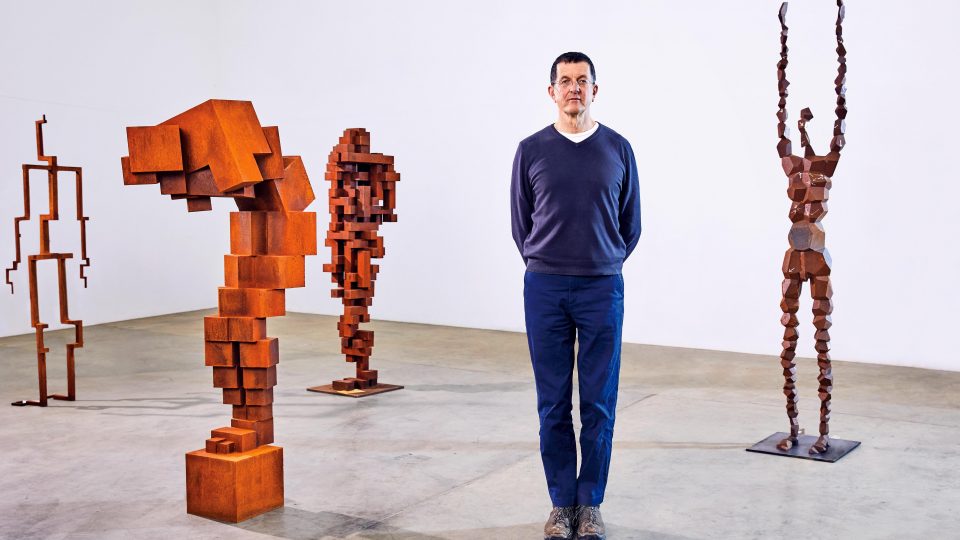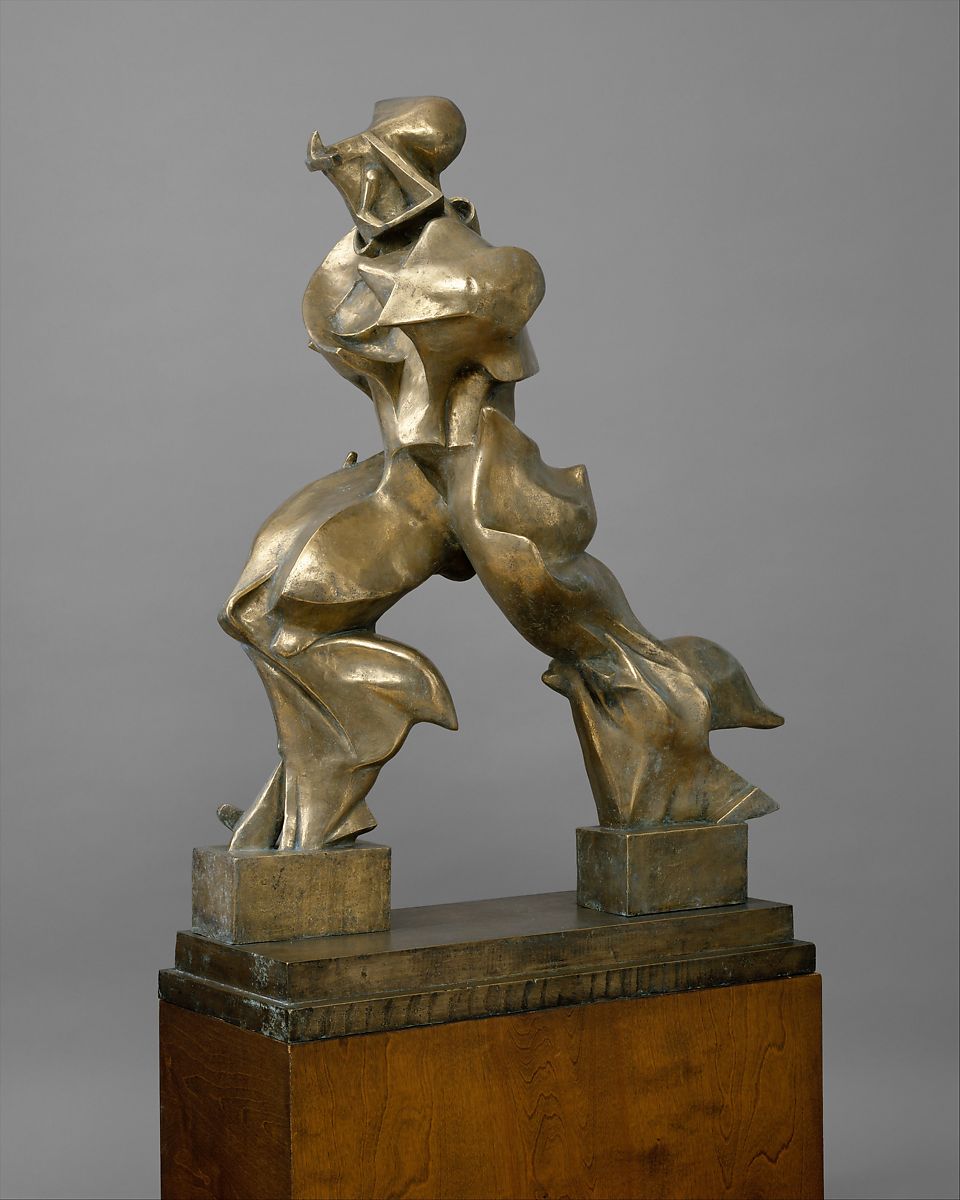
Ph: Todd Heisler, The New York Times
The relation between body and space is a key element in modern and postmodern art. Antony Gormley’s installation Event Horizon and Umberto Boccioni’s bronze sculpture Unique Forms of Continuity in Space deal with the same issue but reach an opposite result, the first one targeting stillness while the last one highlighting dynamism. The use of sculpture in both artworks shows how diverse the concept of the medium varies in different epochs. Moreover, the Italian artist wanted to unleash the expansion of man’s energies in bronze, the deformation of the body by wind and speed becomes crucial to represent modernity’s positivist impact on humans. Contrarily, Gormley’s iron sculptures use the physical means to talk about the spirit, something which is weightless and dark – sculpture becomes a visual means to refer to things which cannot be seen because they are hidden in the infinity of space within the body.

Ph: Robert Wilson, The Times
A fundamental point of research for the British artist Antony Gormley is the endless possibilities detained by the essence of a body, focusing on the social impact that art has, specifically in a postmodern industrial context. This is the landscape – which becomes part of the subject in Gormley’s art – chosen for his installation Event Horizon, first presented in 2007 in London, the city where the artist’s studio is located. It was then transferred to other cities even beyond Europe, including New York, Hong Kong, São Paulo and Rio de Janeiro. Iron was the predominant material and it is the artist himself who explained the reason behind this choice; it represents both 85% of this planet and it is also the element found in red blood cells, suggesting the link between the human body and more enduring bodies in space. These life-size sculptures were placed in different parts of the cities’ skylines. The stillness of these iron bodies – moulded on the artist’s naked body – contrasted with the anxiety of the postmodern industrialised city. The aim of this installation was to spark interaction with the viewers who stopped and observed the figures. At first, this seems like a simple result but looking more closely at Gormley’s artistic thought process, what he wanted to obtain was stillness, contrasting with the dynamism which permeates the modern city, encouraging us to look beyond the surface and the horizon. According to Gormley, it pushes to the consciousness of space and therefore the body becomes the means of the unknowable and unseeable. It is very interesting to observe Gormley’s casting process, as he himself described for the Konsthall Malmö exhibition catalogue (1993): “I adopt the position which I have selected for a sculpture and am wrapped in scrim and plaster. Because the plaster dries quickly […] the work is divided into different sections. The whole process takes about an hour, perhaps an hour and a half. Then I am cut out of my mould and it is reassembled. You are aware that there is a transition, that something that is happening within you is gradually registering externally. I concentrate very hard on maintaining my position and the form comes from this concentration.” The body becomes for Gormley a key to investigate the relationship of the human body to space and of the human beings in relation to nature and the cosmos.

Left: Unique Forms of Continuity in Space, Umberto Boccioni, 1913, cast 1950, MET, New York 
Umberto Boccioni in 1914
We can notice that the medium of sculpture is also adopted by the Italian Futurist artist Umberto Boccioni in order to explore the body but instead of focusing on the stillness and philosophical reflection, Boccioni decides to embrace modernity, celebrating energy and dynamism. These elements are present in one of his most famous bronze sculptures titled Unique Forms of Continuity in Space, created in 1913, just one year before the First World War started. In total, there are eleven casts of this sculpture that were created posthumously but the original plaster is permanently displayed at the Museum of Contemporary Art of the University of São Paulo, Brazil. With the start of the 20th Century, artists started thinking about the fourth dimension, defined by Linda Dalrymple Henderson as the “unseen dimension of space which might hold a reality truer than that of visual perception.” While the Cubists were trying to use geometry in order to represent the fourth dimension, Boccioni decided to focus on chronophotographic views transferred on sculpture. As the artist himself wrote in 1913 in the Technical Manifesto of Futurist Sculpture, the fourth dimension is not measured and finite, “but rather a continuous projection of forces and forms intuited in their infinite unfolding”. Hence, Unique Forms of Continuity in Space does not depict a particular person at a specific moment but rather synthesizes the process of walking into a single body which blends the human and the machine. Futurist artists – contrasting with Antony Gormley’s idea of philosophically analysing the present – are projected to the future, a time in which humans and machines will coexist. Characterised by strong opposition to the classical past, Futurist artists glorified progress and war, celebrating the violent burst of modernity. The type of human that Boccioni is promoting is the Übermensch, a term coined by Nietzsche that describes the ‘superior man’, a man who goes beyond the socially-constructed morality, reaching the creation of his own values based on his own experience in the world.

Both Antony Gormley and Umberto Boccioni use art as a tool to investigate the relation between body and space. While on one hand Boccioni sustains that the body is plastic dynamism subjected to the change of the modern environment, on the other hand Gormley goes towards the opposite way; the body becomes a physical container of the person’s inner feelings, thoughts and imagination which creates an objectless, dimensionless, limitless and endless space. The difference between Boccioni’s view of modernity and Gormley’s on postmodernity is complex to define but one main variation would be that the Futurist belief in progress is substituted by the uncertainty and the need of reasserting our first-hand experience in the present time.